
Vintage “Lemondrop” Refinish
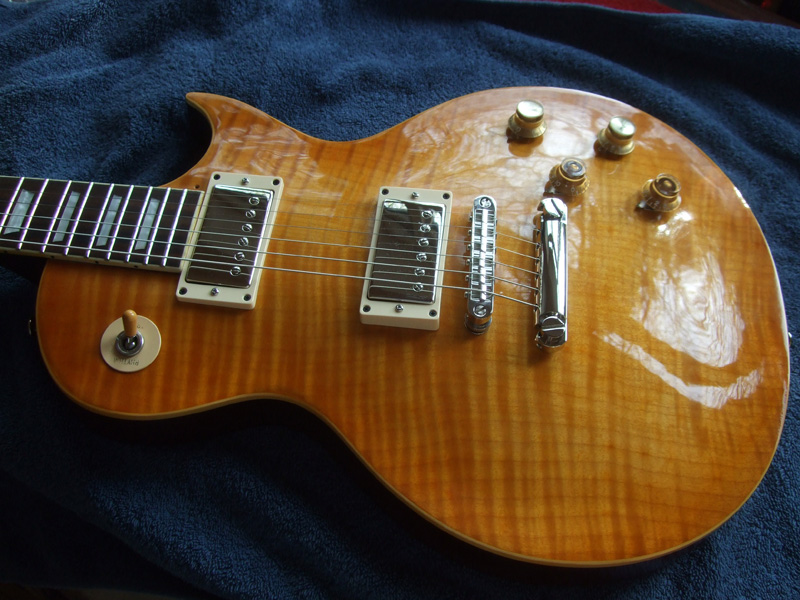
The owner of the Vintage Lemondrop guitar that I upgraded some time back asked me to refinish the top. Thinking that the finish would be thin and strip easily, I agreed. I discovered however that the finish is thick, tough and difficult to remove.
I stripped the top over a couple of weeks and probably spent about ten hours on the job altogether! My fingers lost their feeling from the vibration of the mouse sander.
Once I had the finish off, I sanded with the grain using 320 grit sandpaper to give a smooth surface.
Stripping the top required a lot of care as the flame maple veneer is quite thin and I didn’t want to damage it. I’m glad to say that I didn’t.
I sprayed a few coats of cellulose sanding sealer, and sanded it back to give a smooth surface. You can see that some colour remains from the factory dye.
I then followed with Clear Amber and then used my Tinted Gloss to give a barely perceptible “unburst” edge.
Once happy with the colour I sprayed plenty of Clear Gloss nitrocellulose lacquer to seal and then after a few days flatted back and buffed to a shine before reassembling.
Here’s a closeup.

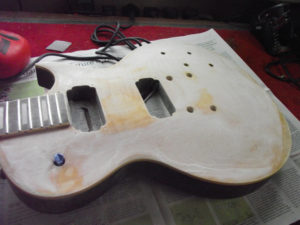
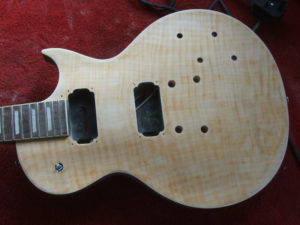
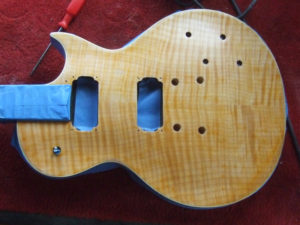
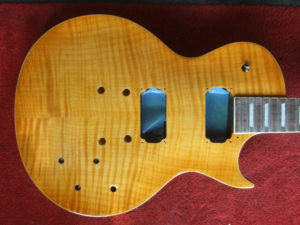
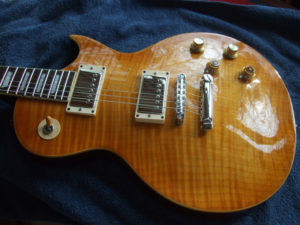
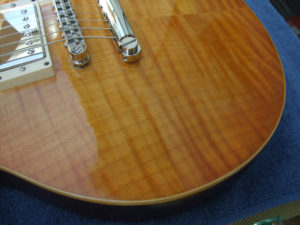
Hi Steve. Could you point me in the direction of link to a new toggle switch for my lemondrop? Thanks. David.
They are fitted with cheap switches like this one, you can find them on eBay for about a fiver.
If I were replacing one though, I’d fit a Switchcraft version like this. They are much better built if a bit expensive.
If you do change to a Switchcraft version be aware that the solder tags are arranged differently, with the “output” and earth tags at the opposite ends.
Is it possible to achieve a similar colour finish using gun stock oil?
Looks fantastic! What was the finish you removed? Was it poly or nitro? Could a nitro top co-exist with a poly body?
The finish on these is polyester of course. You can spray nitrocellulose over polyester without problems so long as you scuff sand first to provide a key.
Cheers, the key here I guess is not to go through the veneer! Did you only sand or start out by careful scraping? What grades of abrasive would you recommend?
Sanding only. Started out with 80 grit I think and then down to 320 for the final sand. It does take a long time and a lot of care not to go through the thin veneer.
Cheers, much appreciated. Thanks for the info, supplies and the inspiration your site provides.
hi, i completely agree with previous comment, youve done a quality job. im pretty fgood my query – im about to start painting an aria sb special pro 2 bass. how many tins of sanding sealer did you use to seal timber grain? how many tins of clear amber? & tinted gloss? and finally how many tins of nitrocellulose lacquer did you use for the project? finally, how does the final cost of painting diy compare with getting this done by a paint shop? ive know idea as ive not enquired, but im pretty handy with my hands and im meticulous and patient when working on guitars so im up for it, if the cost of buying the areosols you used dosnt outweigh getting it done by a guitar paint shop. regards roberto
Hi Roberto. Clearly it will take a lot more lacquer to paint a bass than just the top of this guitar.
You’ll probably need one can of each of sanding sealer, amber and tinted lacquer, plus at least two of clear gloss lacquer. It should still cost a lot less than a professional refinish.
awesome work, just what I was looking for,you really have to start selling the lacquers to Portugal. It is unfair not being able to find such good quality products over here
Thanks. Yes I can send to most of the EU, at least while we are in the EU. Long may it continue!